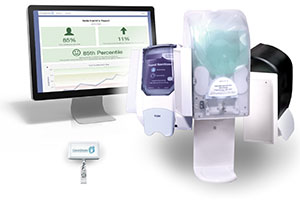can provide insights for nurse managers that could lead to reminding staff to perform hand hygiene during busy hours of the day.
Facilities professionals should be concerned about the footprint of electronic monitoring systems, how easy it is to integrate the technology into existing hand sanitizer and soap dispensers, and whether the systems require integration with the information technology (IT) infrastructure, according to Pearsall. “The DebMed System is not integrated into the hospital’s IT infrastructure. All dispensers are monitored and the data is transmitted wirelessly, without using Wi-Fi, to an off-site server. Users log on to a website to view their reports or the reports are emailed to them.”
Proventix Systems Inc. uses a low-voltage wired system to ensure consistent data flow on the front end and a high level of data collection. “Battery-operated systems can underperform when batteries are low. The Proventix nGage Reporting Suite is available via a secure website for all users, driving change where hand washes are missed during patient care and providing consistency in patient rounding and infection trending by source,” Lee says. “Also, the data included in the nGage system allows hospitals to recognize changes in nursing workflow and time-efficiency variations.”
Other features
The latest HHCM innovations incorporate the aforementioned data-gathering and analytical capabilities. Among recent introductions to the health care market, DebMed has unveiled version 2.0 of its electronic HHCM system. It features enhanced compliance reports, optimized navigation and an easy-to-read dashboard that automatically generates reports when users log on to the website.
CenTrak’s HHCM system can be used as a stand-alone solution or as part of its enterprise location services platform in which data can be viewed at the hospital, department or individual level.
CenTrak staff badges leverage a real-time locating system (RTLS) to communicate with dispensers and automatically collect compliance data. This information shows how health care workers are washing their hands in comparison to hospital hand-hygiene protocols. Failure to comply with these protocols results in a gentle reminder from the staff member’s RTLS-enabled badge.
The HHCM solution from Stanley Healthcare, Waltham, Mass., is part of its AeroScout enterprise RTLS platform and features hand-hygiene-specific dashboards in a MobileView visibility platform. Caregivers wear Wi-Fi badges that identify them in the system, along with two receivers — one for ultrasound, one for low frequency — to capture room entrances/exits and the use of hand sanitizer dispensers, respectively. Patient rooms and other relevant areas are equipped with an ultrasound exciter to record each instance that the caregiver enters or exits. This creates hand-hygiene opportunities when caregivers are expected to clean their hands.
“MobileView Analytics dashboards provide easy visualization of the data with the ability to drill down into different locations or times to understand trends and training opportunities,” says Sagi Geva, director of acute care solutions, Stanley Healthcare. “In addition, we created a leaderboard that shows individual results on a unit in near-real time, which creates healthy competition and drives caregivers to improve compliance.”
Ecolab has introduced a monitoring system that measures hand hygiene within an electronically monitored zone that can be created around a patient bed, stretcher or crib. A badge uses both lights and sounds that alert health care workers to the state of their compliance. The system can monitor compliance by individual, department, shift or the entire facility.
Biovigil recently unveiled its 5.0 platform, which offers a new base station and user badge that is 50 percent smaller and has features such as wireless user pairing, vibration mode, LED indicator and in-room World Health Organization (WHO) five-moment tracking. In addition, a cross-contamination feature and user alert for isolation rooms ensures that health care workers wash their hands with soap and water upon exiting a C. difficile room.
Clean Hands Safe Hands, Atlanta, offers a natural language voice reminder within its HHCM system that gently reminds clinicians to wash their hands. “We’ve seen in numerous clinical trials that a human voice does a much better job of cutting through the clutter of hospital lights and alarms than a beep or a light on a clinician’s chest,” says Chris Hermann, founder and CEO.
The company’s adaptive room modes customize the system for rooms where patients have special needs. In C. difficile rooms, the voice reminds clinicians to use soap and water only, and it can be configured to only give credit for soap usage. In isolation rooms, the system gives clinicians more time to don gowns and gloves. It also features a mute button for rooms where there’s an end-of-life situation or where the patient’s care needs require silence.
Clean Hands Safe Hands also offers a six-phase hand-hygiene acceleration pathway that helps hospital teams to achieve continuous improvement in a way that easily adapts to different cultures. The phases build upon each other in a gamified approach.
The near future
Peck foresees continued efforts to fully integrate electronic monitoring sensors into soap and alcohol dispensers for improved measurement of hand washing as well as the amount of cleaning product that is dispensed. For his part, Geva predicts future HHCM systems will more accurately monitor the WHO five moments and identify the correct opportunity when hand hygiene is required, thus ensuring more accurate hand-hygiene compliance rates for busy clinical staff.
Neal Lorenzi is a freelance writer based in Mundelein, Ill.

Getting personal
This hand-hygiene performance system features adaptive room modes that allow users to customize the system for rooms where patients have special needs. Clean Hands Safe Hands